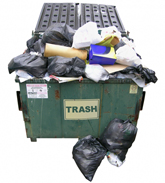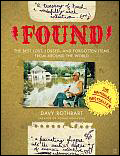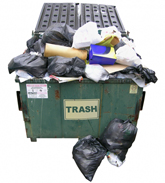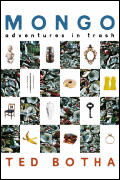Flo and Channing, a pair of occasionally employed, twentysomething hipsters in lower Manhattan, live well. At least, they eat well. They favor sushi and vegetarian pizza and soy milk and artisan bread, and they also like to indulge in custard pastries, chocolate-covered strawberries, chocolate croissants, and Krispy Kreme doughnuts. They’re especially fond of waffles. And they eat it all for free. All they have to do is spend a few hours each night lurking outside restaurants, rescuing their favorite menu items from the trash. “Sometimes, people see what we’re doing and say, eee-yew, how gross,” says Flo. “Other times they offer to buy us a meal. We just say, no thanks, we have plenty of food here.”
For the intrepid few, that old environmental mantra of reduce-reuse-recycle is more than a weekly chore. It’s a passion, a habit, an addiction, a career, or — as in the case of Flo and Channing — a mix of idealism and economic necessity. Such scavengers go by many names. “Freegans” fill their pantries with discarded food, half a million “freecyclers” exchange possessions on the internet, and a varied array of collectors rescue treasures from sidewalks and garbage dumps. In many cases, these dedicated scroungers operate undercover, fearing competition, reprimands from the police, or social censure. Now, though, the secret appears to be out. Two new and very different books expose the often nasty, frequently exhausting, and sometimes exquisitely pleasurable world of habitual trash picking.
In Mongo: Adventures in Trash, journalist Ted Botha follows several serious “collectors” on their rounds through New York City neighborhoods. His subjects span the economic spectrum. Some, such as the homeless and semi-homeless aluminum-can gatherers, collect to survive. Others, such as an architectural restorationist given to climbing into dumpsters on his way to black-tie dinners, do it purely for pleasure. Most are somewhere in between.

Behold, a mongo paradise.
In the complex hierarchy of collectors, writes Botha, “black-bag people” — those willing to risk hands-on searches through opaque plastic bags — occupy the bottom rung. Less desperate souls scan clear plastic bags, brave encounters with unfriendly doormen to pick up discarded furniture, or dig into landfill dirt and old outhouse sites for historical treasures. No matter their social status, they’re all after “mongo,” New York slang for any discarded item that gets picked up and reused. Their finds are a relatively small part of the city’s massive waste stream, but the valuable stuff they encounter — near-perfect linens, for instance — hints that a lot of things get thrown away that shouldn’t.
Collectors aren’t exactly media-friendly. Many run away as Botha approaches, and those who hang around to talk are often wary of revealing their identities and their favorite collecting spots. As a result, some of Botha’s profiles are a little shadowy, lacking the biographical details that might explain the collectors’ most fundamental motivations. Nonetheless, his reportorial scavenging yields some great characters. There’s Steven Dixon, a laid-off banker who prowls uptown neighborhoods at dawn for valuable books. During one of his rounds, a cop thought he looked suspicious, and wrestled him to the ground. Steven, as he tells it, was unfazed. “How many burglars,” he asked, “do you see running around with a copy of Shakespeare?” Or there’s Christiana, who taught herself to rebuild discarded computers; and Jeffrey, who painstakingly turned a brownstone in the Bowery into a fantastically beautiful work of mongo art.
Though many collectors earn some money from their trade, Botha finds that nearly all of them — even a few of the most desperate — get some less quantifiable satisfaction from it. For most collectors, there’s the rare thrill of getting something coveted for free. Some can collectors, meanwhile, appreciate their entrepreneurial freedom, and a pair of amateur urban archaeologists gets a charge out of finding old and potentially valuable glass bottles. “There’s a certain joy to using stuff that’s been thrown away,” says Iver Iversen, the dumpster-frequenting restorationist, who once grabbed a pantry door discarded from Jackie Onassis’ apartment. “It’s very satisfying knowing that it is no longer going out to [a landfill on] Staten Island.”

Found,
by Davy Rothbart,
Fireside,
256 pgs., 2004.
Tossed and Found
Other collectors aren’t after money, or even home furnishings. They’re simply searching for surprises. Found: The Best Lost, Tossed, and Forgotten Items From Around the World is a scrapbook of anonymous notes, emails, letters, and photos, scavenged from sidewalks, subways, and copy shops by the readers of Found magazine. Davy Rothbart, the creator of Found (and a contributor to public radio’s This American Life), writes, “Found notes and letters open up the entire range of human experience; they offer a shortcut directly into people’s minds and hearts.”
Found is, in short, a paradise for the nosy. Reading the book is a bit like pawing through the trash, minus the slime. It’s visually messy, containing hundreds of Xeroxed scraps of paper, photos, pen-and-ink drawings, and homemade labels. It can be funny and crude (“DAD,” reads one scrawled note, “Come get me @ the coffee shop when your done taking a crap”) or deeply sobering — or, sometimes, both. (“Dear Ron, the longer I think about what I’m doing the sicker I feel … I love you but things have not been the same since we found out that we were related.”) It reminds us of what it is like to live among our fellow humans: “Just wanted to let you know that your [car] alarm has been going off STRAIGHT for many days … PLEASE do something about it … Thanks! The Whole Block.” And: “WARNING: The iguana is loose on the porch. Before entering, make damn sure that she is not going to bolt out the door.” And it hints at the troubled lives around us, as in a letter from prison, and an earnest note from a kid asking his parents to kick their drug habit. As Rothbart points out, the things you don’t know about the writers, the things you are left to speculate about, are as fascinating as the bare details the documents reveal.
Both Found and Mongo have a grimy modern edge, but many collectors turn out to be nostalgia hounds. Some of Botha’s mongo collectors are explicit curators of the past, out to save or resurrect Gothic rooms, old statuary, or even outdated computers. Others look back in more subtle ways. The aluminum-can collectors carry on a tradition established by ragpickers, who collected fabric scraps and other castoffs to sell for a few cents per pound in old New York. Young, radical dumpster divers like Flo and Channing practice a kind of urban harvest, outwitting consumerism by creating a contemporary version of the thrift of previous generations.
Rothbart’s collection, too, has its old-time undertones. Found is a scrappy reminder that, in a time of pricey camera phones and special-edition DVDs, some forms of entertainment and inspiration still come absolutely free. The everyday chore of reducing, reusing, and recycling may have its moral satisfactions, but these creative forms of scavenging offer something more: They can make the practice fun.



